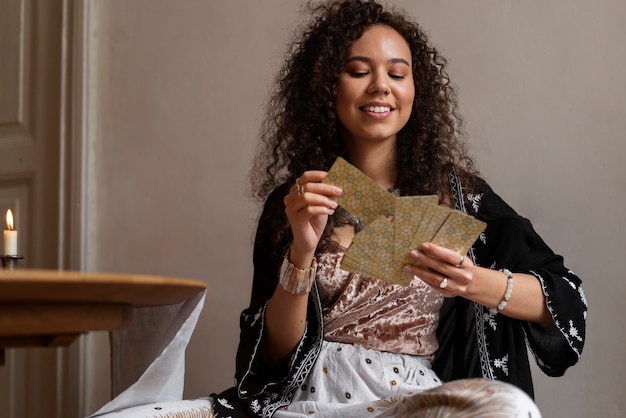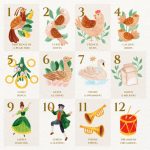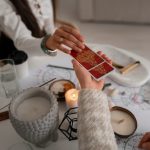
Welcome to the all-inclusive tarot reading guide! This guide will be incredibly helpful as you dive into the fascinating world of tarot, regardless of whether you’re a novice or an expert.
Whether you’re interested in the history of tarot, understanding different decks, or becoming an adept reader, this guide covers it all. You’ll find sections on choosing the right tarot spreads, preparing your cards, and interpreting the meanings for yourself and others. Enjoy the enchanting journey into tarot cards!
Tarot cards first appeared in 14th-century Europe as an Italian card game with four suits. Notable decks include the “Visconti-Sforza” from the 1440s and the “Mantegna” deck from the 1470s. In the 16th century, tarot became linked with mysticism. By the 18th century, some believed the 22 Major Arcana cards held ancient Egyptian wisdom.
A typical tarot deck has 78 cards, divided into the Major and Minor Arcana. The Major Arcana consists of 22 cards depicting significant life themes, while the 56 Minor Arcana cards are split into four suits: wands, cups, swords, and pentacles, representing earth, water, air, and fire. Each card has an upright and reversed meaning, which can greatly impact the reading. Some readers use both meanings, while others prefer only upright interpretations, depending on the depth of detail needed.
Here’s a brief on some major card meanings:
– **The Fool:** Represents a fresh start and youthful enthusiasm. Embrace its energy without fear.
– **The Magician:** Highlights your unique skills and resources to achieve your goals.
– **The High Priestess:** Symbolizes intuition. Trust your inner voice.
– **The Emperor:** Denotes stability and authority, often indicating career success.
– **The Lovers:** Focuses on relationships and important choices.
– **The Chariot:** Embodies drive and determination, suggesting possible victory.
– **Strength:** Stands for resilience and a strong heart to overcome challenges.
– **The Hermit:** Suggests finding wisdom through solitude.
– **The Wheel of Fortune:** Indicates life’s constant changes and the lessons they bring.
– **Justice:** Reminds you that actions have consequences.
– **The Hanged Man:** Suggests the benefits of making small sacrifices.
– **Death:** Often points to change and transformation rather than literal death.
– **Temperance:** Encourages patience and balance.
– **The Devil:** Represents feelings of being stuck but also the potential to overcome obstacles.
– **The Tower:** Indicates disruption, advising you to let go of weak aspects of your life.
– **The Star:** Symbolizes hope and inspiration.
– **The Moon:** Brings attention to hidden emotions and advises caution.
– **The Sun:** Brings joy and positive progress.
– **Judgement:** Encourages self-reflection and making positive changes.
– **The World:** Represents completeness and fulfillment.
The Minor Arcana’s four suits represent different life aspects:
– **Cups:** Emotions, relationships, and intuition.
– **Wands:** Creativity, action, and passion.
– **Swords:** Challenges, intellect, and communication.
– **Pentacles:** Material aspects, career, and health.
Popular tarot decks include:
– **Rider-Waite:** Renowned for its detailed imagery and symbolism.
– **Thoth Tarot:** Known for its esoteric and symbolic designs by Aleister Crowley.
– **Wild Unknown Tarot:** Features minimalist, nature-themed artwork.
– **Shadowscapes Tarot:** Offers a fresh take with intricate watercolors.
– **Gendron Tarot:** Combines traditional meanings with striking art.
– **Black and White Tarot:** Uses monochrome art to focus on symbolism.
– **Tarot of Dreams:** Known for its fantasy-inspired imagery.
Different types of tarot readings serve various purposes:
– **General Readings:** Provide broad insights into life.
– **Question-based Readings:** Address specific inquiries.
– **Theme-based Readings:** Focus on specific aspects like love or career.
– **Past or Future Readings:** Explore events from a specific timeframe.
– **Yes-or-No Readings:** Provide simple answers to binary questions.
– **One-Card Readings:** Offer quick, focused insights.
To get the most out of a tarot reading:
– **Connect with your deck**: Choose one that resonates with you.
– **Understand the card meanings:** Study imagery and symbolism.
– **Define your reading goal:** Determine what you want to know.
– **Prepare your space:** Ensure a quiet, sacred environment.
When reading for others, maintain clear boundaries and encourage a comfortable space. Explain your process and ensure you’re sensitive yet honest in your interpretations.
Choosing a tarot spread depends on your reading focus. Simple spreads, like the one-card or three-card, are great for daily guidance, while the Celtic Cross is perfect for detailed insights. Decision spreads help evaluate options, and the Pentagram spread provides a balanced view of a situation.
To prepare for a reading, understand the type you want and find a quiet place. Research and select a knowledgeable tarot reader if you’re seeking professional insights. Remove negative energies and approach the reading openly.
Clear your deck’s energy regularly, using methods like shuffling, crystals, or meditation. Personalize your deck to enhance your connection, and always consider the relational context of the cards during interpretation.
Online tarot readings offer convenient access to skilled readers. Trusted Psychics, for instance, provides accurate insights with professional readers, making it easy to get a reading from the comfort of your home.
Starting with tarot involves learning the card meanings, understanding different spreads, and honing your intuition. It’s possible to perform readings for yourself, which can be a powerful tool for self-discovery.
Tarot readings usually involve multiple cards based on the type of spread you choose. Whether it’s a single card for a quick answer or a 10-card spread for comprehensive insights, the number of cards and their meanings vary.
In summary, tarot is a versatile tool for gaining clarity and guidance in various aspects of life. Whether you’re exploring it for personal growth, relationship insights, or career decisions, the key lies in understanding the cards, connecting with your deck, and honing your intuitive skills. Whether you’re new to tarot or an experienced reader, this guide provides the foundational knowledge to help you navigate this mystical practice.


